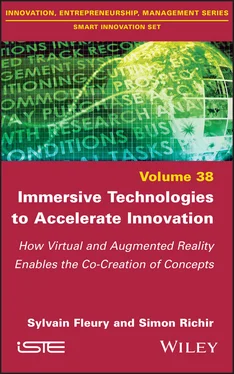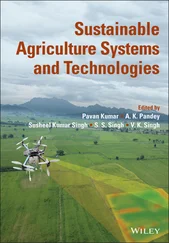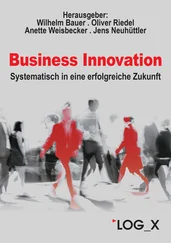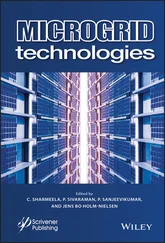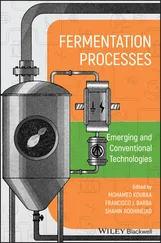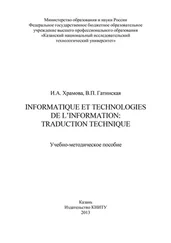121 114
122 115
123 116
124 117
125 118
126 119
127 120
128 121
129 122
130 123
131 124
132 125
133 126
134 127
135 129
136 130
137 131
138 132
139 133
140 134
141 135
142 136
143 137
144 138
145 139
146 141
147 142
148 143
149 144
150 145
151 146
152 147
153 148
154 149
155 150
156 151
157 152
158 153
159 154
160 155
161 156
162 157
163 159
164 160
165 161
166 162
167 163
168 164
169 165
170 166
171 167
172 168
173 169
174 170
175 171
176 172
177 173
178 174
179 175
180 176
181 177
Smart Innovation Set
coordinated by
Dimitri Uzunidis
Volume 38
Immersive Technologies to Accelerate Innovation
How Virtual and Augmented Reality Enables the Co-Creation of Concepts
Sylvain Fleury
Simon Richir

First published 2021 in Great Britain and the United States by ISTE Ltd and John Wiley & Sons, Inc.
Apart from any fair dealing for the purposes of research or private study, or criticism or review, as permitted under the Copyright, Designs and Patents Act 1988, this publication may only be reproduced, stored or transmitted, in any form or by any means, with the prior permission in writing of the publishers, or in the case of reprographic reproduction in accordance with the terms and licenses issued by the CLA. Enquiries concerning reproduction outside these terms should be sent to the publishers at the undermentioned address:
ISTE Ltd
27-37 St George’s Road
London SW19 4EU
UK
www.iste.co.uk
John Wiley & Sons, Inc.
111 River Street
Hoboken, NJ 07030
USA
www.wiley.com
© ISTE Ltd 2021
The rights of Sylvain Fleury and Simon Richir to be identified as the authors of this work have been asserted by them in accordance with the Copyright, Designs and Patents Act 1988.
Library of Congress Control Number: 2021943895
British Library Cataloguing-in-Publication Data
A CIP record for this book is available from the British Library
ISBN 978-1-78630-770-5
The need for change in a company often translates into a real need to adapt in order to survive, especially in a constrained environment; in other words, it is a matter of innovating or dying. This was well illustrated during recent crises, for example in 2008 with the financial crisis, when, even under reduced resources, the accelerated change toward an “open innovation” model with external partners, academics, customers and suppliers, enabled us to prepare for the rebound after the crisis. More recently, during the Covid-19 pandemic in 2020, the rapid use of digitalization and the electrification of transport are already preparing us for environmental challenges, particularly related to global warming and the necessary reduction in the use of fossil fuels. In this changing world, the innovation process facilitates change and creates a positive, continuous and visible dynamic. This process is useful for companies to focus efforts at the right time, with the right intensity, in the right place, with competent and prepared teams. The notions of market and temporality are also crucial. Without a market, innovation will only remain at the invention stage, an expense for the company with no return on investment. To be successful, this implies a continuous intimacy with customers, a shared value creation process. The innovation process must also adapt to the context and make the most of available technologies, wherever they may be, from our suppliers, our academic partners, and public or private research. The meeting with the teams working at the Laval Virtual Center and the work carried out with the Institut Arts et Métiers de Laval have enabled MANN+HUMMEL, a leading global company in filtration technology, to strengthen its strategy in the field of digitalization, by seeking to create value from digital data, and by applying it to the innovation process. The speed with which we can interact with our customers in our ideation processes, up to the realization of prototypes, real or virtual, is an important factor in convincing future customers, investors and internal or external decision makers. In 2016, based on this observation, the collaboration between MANN+HUMMEL and the Institut Arts et Métiers de Laval was initiated in order to conduct research and experimentation on the contribution of technology, related to virtual reality, to the innovation process. This project is called “Time to Concept”, and its objective is to reduce the time between ideation and the first customer experience. It is about putting the user or the customer at the center of the game by immersing them, gathering their emotions and feedback, and taking these into account in real time to adapt the product or the service. It is also of course about converging, at the end, on a creation of value, demonstrated in the virtual environment, with system interactions made more visible. For example, during a recent car show in Frankfurt, we managed to put a few customers under virtual reality headsets to gather their impressions of a new vehicle interior filtration system: a situation lasting less than two minutes to explain everything, in particular to visualize the invisible, that is, the improvement of the vehicle’s air quality. Remembering the experience, one of them, a world-renowned car manufacturer, then selected us to create a demonstration vehicle. In the field of air quality improvement, which is one of the strategic axes of the MANN+HUMMEL Group, we try to make visible with the help of virtual reality the physical phenomena at stake, such as fluid mechanics, the propagation of pollutants and their filtration. Explaining them is all the more necessary to bring to the market new and more efficient filtration technologies, adapted to the new uses of mobility and our lifestyles, and also in tune with the new recommendations and regulations in this field. Thus, this book describes the generic results of research work validated in concrete cases to support the digital transformation of innovation within companies through immersive technologies.
Jérôme Migaud
Transportation Innovation Director
at MANN+HUMMEL Group
September 2021
We would like to thank our industrial partners for providing us with study sites and opportunities to evaluate the methods described in this book in real-life situations. In particular, we would like to thank MANN+HUMMEL for their contribution through the financing of the Time to Concept Chair, which has given rise to a number of the research projects presented in this book. We think in particular of Jérôme Migaud, Bruno Langer, Philippe Rhoumy and Luc De Keyser. Our thanks go to the Arts et Métiers Foundation for its support to the Chair, in particular Gilbert Paulezec and Roger Stanchina, but also Aurélien Agnès who supported us for 1 year in this scientific program. Of course, we would like to thank the representatives of the steering committee of the Time to Concept Chair: Jean Quessada, Ivan Iordanoff, Alexandre Rigal, Xavier Château and Xavier Kestelyn.
We would also like to thank Charles Mille for the numerous exchanges that contributed to the reflections on the methods and tools, and also Thibaut Guitter and Benjamin Poussard for their participation in the research work and the design of the virtual reality tools, as well as Marie-Pierre Verrier for preparing the numerous communication and scientific sharing events that punctuated this program.
Читать дальше
